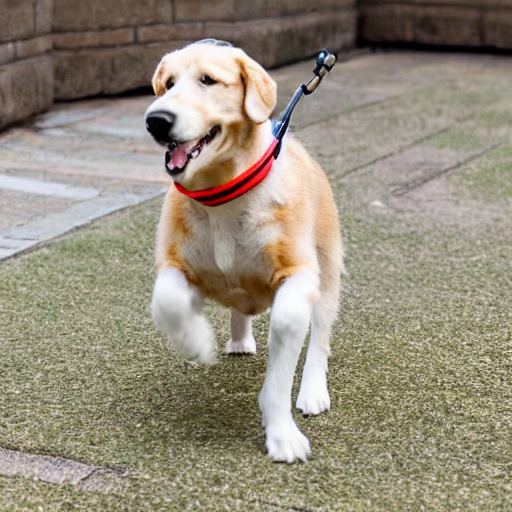Generative Artificial Intelligence (AI) has revolutionized the world of image creation, enabling machines to generate stunning (well maybe not too stunning yet) visuals that were once limited to human imagination. In this blog post, I will delve into the fascinating realm of “FREE” generative AI image creators, specifically exploring and comparing Lexica, Playground, Synthesys X and DALL-E. I will uncover the underlying principles and workings of these tools, highlighting their unique features, applications, and limitations.
4 Free Generative AI Image Creators: The Future of Image Creation
Generative AI image creators are a new type of technology that can be used to create realistic and original images from text descriptions. These tools are still in their early stages of development, but they have the potential to revolutionize the way we create and use images.
For each of the AI Image Creators, I provided the same text prompt “Create an image of a pet walker” I will share the results of each of the results that were produced.
Lexica is a generative AI image creator that uses a large dataset of text and images to create realistic and original images. It is known for its ability to create images that are both visually appealing and semantically accurate. Lexica is an innovative generative AI image creator. Lexica excels in translating textual prompts into visually coherent and contextually relevant images. The underlying model is trained on a massive dataset consisting of diverse images paired with their corresponding textual descriptions.
Lexica’s key advantage lies in its ability to produce detailed and intricate images that closely match the given textual prompts. Users can experiment with various prompts, exploring the boundaries of the AI’s capabilities.
However, due to the complexity of training such models, Lexica can sometimes generate visually inconsistent or semantically vague outputs.
Ease of Use: Web-enabled and very easy to use.
Prompt Results

My Thoughts: Lexica produced a high quality image. I was able to create and download the image without signing up. Generated images within seconds. Overall I am impressed with the ease and fast process I went through to get such a quality image. But upon carefully examining the image , I realized the black dog on the right has no head and is walking backwards. 🥹😅
Playground is another generative AI image creator that is known for its ability to create creative and imaginative images. It is a good option for users who want to experiment with different styles and genres of image creation. One of Playground’s distinctive feature is its versatility. Users can specify a wide range of instructions, including object placement, size, color, and more. Additionally, Playground allows users to modify existing images and generate creative variations. However, despite its flexibility, Playground’s outputs may occasionally exhibit slight deviations from the intended instructions.
Ease of Use: Web enabled and easy to use.
Prompt Results

My Thoughts: Although it was very easy to sign up and use and the image has good quality, I am a bit disappointed with playground’s image because it produced an image of a pet instead of a pet walker.
Synthesys X which is one of my favorites, is a Chrome extension that uses artificial intelligence to create new versions of any image you find online. It works by analyzing the original image and generating new variations that are similar but different. The variations can be subtle or dramatic .
Synthesys X is a great tool for anyone who wants to be more creative with their images. You can use it to:
Remove watermarks: If you find an image you like but it has a watermark, you can use Synthesys X to generate a new version of the image without the watermark.
Change the style of an image: If you want to give an image a different look, you can use Synthesys X to generate a new version of the image with a different style, such as a painting, a cartoon, or a sketch.
Create new content: If you’re an artist or designer, you can use Synthesys X to generate new images that you can use in your work.
Synthesys X is free to use for up to 50 images per month. After that, you can subscribe to a paid plan for more images
Ease of Use: Easy to use. Requires Google Chrome browser.
Prompt Results

My Thoughts: Synthesys | X by far seems to be my favorite image generator. The only limitation is that it can only be used on Google chrome browser for now (Maybe other browser developers are working on theirs currently). But aside that drawback , it generates images easily. This is done by right clicking on any image and using the synthesis extension to regenerate that image. The good thing is the regenerated image is copyright free. Although I was able to generate a pet walker image easily, we can see to of the dogs are walking with only 3 legs and the dog on the far left seems to have its tail all the way to the ground. The pet walkers face also seems a bit jumbled up.
DALL-E is a generative AI image creator that is known for its ability to create images that are both realistic and creative. It is currently in private beta, but it is one of the most anticipated generative AI image creators.
DALL-E opens up new avenues for visualizing concepts that were once difficult to represent visually.
Ease of Use: Web enabled and easy to use.
Prompt Results

My Thoughts: A million thanks to Open AI for creating Chat Gpt and Dall – E. I personally love the image Dall-E created. It was also super easy to sign up and generate the image.
Conclusion
While tremendous progress has been made, there are instances where the outputs may not align perfectly with the intended prompt.
We can see from the results above that some of the dogs had only 3 legs , one dog had no head and one pet had no pet walker. As far as Image creation is concerned , there is more work to be done.
Generative AI image creators work by using a process called deep learning. Deep learning is a type of machine learning that uses artificial neural networks to learn from data. In the case of generative AI image creators, the neural networks are trained on a large dataset of text and images. This dataset helps the neural networks to learn how to associate text descriptions with images.
Whenever you type a text description to a generative AI image creator, the neural networks use their knowledge of the world to generate an image that matches the description. The process of generating an image is typically done in two steps:
Text embedding: The text description is first converted into a numerical representation, called a text embedding. This embedding is a vector of numbers that represents the meaning of the text description.
Image generation: The text embedding is then used to generate an image. This is done by using the neural networks to create a mathematical model of the image. The model is then used to generate the image pixel by pixel.
The quality of the images generated by generative AI image creators depends on the quality of the text description and the size and complexity of the neural networks. In general, the more detailed and accurate the text description, the better the image will be. However, even with a simple text description, generative AI image creators can generate images that are surprisingly realistic and creative.
Generative AI image creators are a new and exciting technology that has the potential to revolutionize the way we create and use images. As these tools continue to develop, we can expect to see even more amazing and creative images being generated in the years to come. However, it is important to be aware of the ethical concerns surrounding this technology and to use it responsibly.
Ethical Concerns About Generative AI Image Creators
As with any new technology, there are also some ethical concerns about generative AI image creators. One concern is that these tools could be used to create harmful or misleading images. For example, they could be used to create fake news articles or to generate images of people or products that do not exist.
Another concern is that generative AI image creators could be used to exploit or violate the privacy of individuals. For example, they could be used to create images of people without their consent or to generate images that are used to discriminate against certain groups of people.
It is important to be aware of these ethical concerns and to use generative AI image creators responsibly. It is also important to support research and development into the ethical use of this technology.

Beautifully written and extremely informative. I tried lexica and I am so impressed with the advancements of AI today. I look forward to a future of new technologies with this.